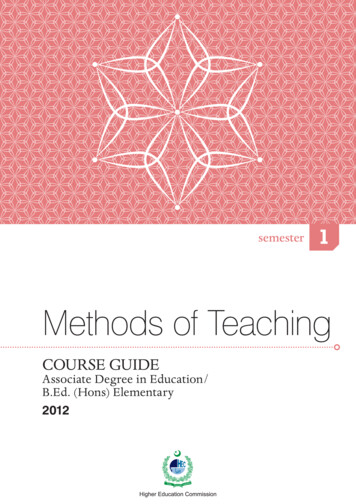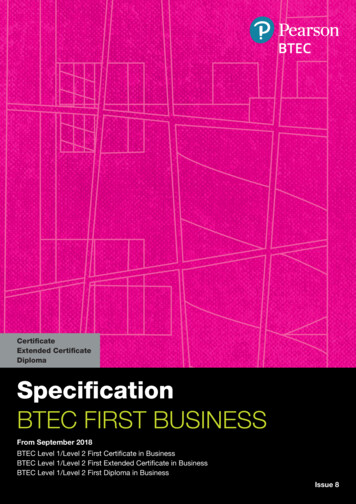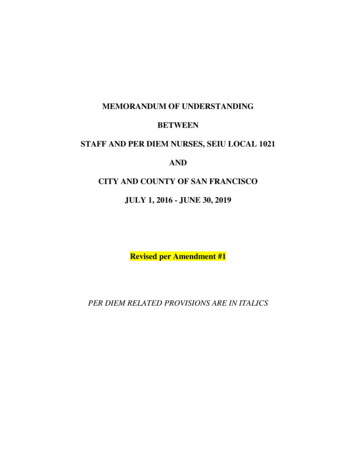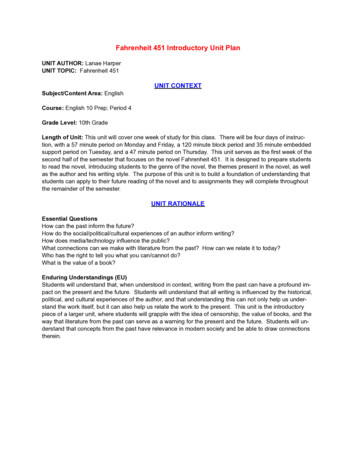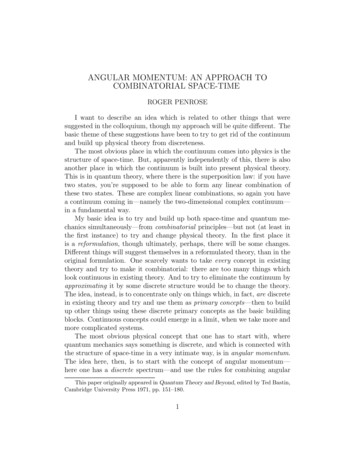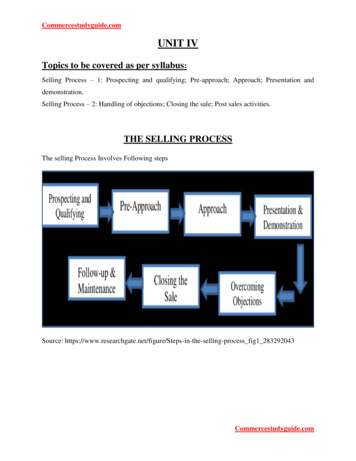
Transcription
Commercestudyguide.comUNIT IVTopics to be covered as per syllabus:Selling Process – 1: Prospecting and qualifying; Pre-approach; Approach; Presentation anddemonstration.Selling Process – 2: Handling of objections; Closing the sale; Post sales activities.THE SELLING PROCESSThe selling Process Involves Following stepsSource: elling-process fig1 283292043Commercestudyguide.com
Commercestudyguide.com1. IDENTIFYING AND QUALIFYING PROSPECTSProspecting is the first stage of the selling process. Prospecting is the lifeblood of sales because itidentifies potential customers.” A steadily growing list of qualified prospects is important forreaching the sales targets. A prospect is a potential buyer.According to Futrell, “A prospect is a qualified person or organisation that has the potential to buythe good or service, provided he has the money to buy, authority to buy, and desire to buy.1. A good prospect is someone who has a problem that the product can solve efficiently andcost-effectively.2. A good prospect has a goal that the company’s product can help to achieve:3. A good prospect has the power to make the buying decision:4. A good prospect is someone who likes the salesman, the company, as well as theirproduct5. A good prospect is a center of influence; someone who can open doors for otherprospects:6. A good prospect is easy to sell to and service:7.A. IDENTIFICATION OF PROSPECTSThe identification of potential customers is not an easy job, especially for a new sales person.Rejection rate is quite high and immediate payoffs are usually minimal. Following are the methodsof identifying prospectsa) Cold Canvassing: salesperson goes from door-to-door and tries to impress upon theprospects. Cold canvassing means face-to-face interview with the people. At the end ofcold call, the salesperson must give his visiting card, so that the prospect could call thesalesperson. If at the time of cold call, a person had shown interest he may be ready to buy.b) Present Satisfied Customers: Customers who are satisfied give the names of those whoare interested in similar products, The Insurance Advisor of Birla Sunlife Insurance asksfive names of the persons who are known to the customer and are in need of insuranceproducts.Commercestudyguide.com
Commercestudyguide.comc) Telephone Directory or Mailing List: Prospects names can be generated throughtelephone directory or mailing lists. In India, specialized companies compile lists ofindividuals and organizations for direct mail advertisers. A sales person may also find thatmembership directories of trade associations, professional societies, and civic and socialorganizations are good sources for prospects.d) Spotters: Some companies use spotters as a source for prospecting potential customers.Spotters are usually ‘sales trainees’ who help sales person identifying prospects, thussaving time and qualifying sales lead.e) Trade shows and exhibitions: A cost effective way to make personal contacts and locateprospective buyer is to participate in trade shows and exhibitions. In view of the risingcosts of personal selling trade shows have become an increasingly important source ofprospecting. India International Trade Fair organized by Trade Fair Authority of Indiaevery year provides a good example of usage of trade shows for prospectingf) Non-competing sales Force: Prospects names can be got from salespersons ofnoncompeting products. A salesperson supplying copiers can tell about computers. Onecan know by listening or observing the buyer of the products.g) Bird-dog Method: ‘Bird dog’ is the nick-name given to the persons who visit the housesat a definite interval. Often, we have electric or water meter readers, gas boys, milknsuppliers, news-paper boys, watchmen.B. QUALIFYING PROSPECTSOnce the sales person has identified potential customers, he or she must qualify them to determine,if they are valid prospects. Unless this is done, time and energy is wasted in trying to sell to peoplewho cannot or will not purchase the product or service.a) Money: Does the prospect have the money or resources to purchase a product or service?b) Authority: Does the prospect have the authority to make commitment?c) Need: Does the prospect need the product or service?2. PREAPPROACHThe pre-approach step includes all the information gathering activities necessary to learn relevantfacts about the prospect. It is an effort to get details regarding the prospect such as his ability, need,Commercestudyguide.com
Commercestudyguide.comauthority, accessibility to buy; it is a closer look of prospects, likes and dislikes, tastes, habits,financial status, social esteem, material status, family background and the like.IMPORTANCE OF PRE-APPROACHa) Pre-approach helps in saving valuable time, effort and energy of the salesperson in the bestinterest of the organisation in which he worksb) Pre-approach makes the salesperson more confident and enthusiastic while meeting theprospects and putting forth the sales proposition before them. The confidence andenthusiasm is the cumulative result of the detailed background information about theprospects collected during pre-approach.c) Pre-approach enables the salesperson to know beforehand about the needs andrequirements of the prospects in the most detailed manner possible.d) By pre-approach, the salesperson’s knowledge about the prospects is considerablyenhanced. As the salesman has prior information about the financial status, likes, takesatthesubsequent stages of sales presentation.e) the salesperson can plan out the sales talk in advance and present the same on systematiclines for assured success. Salesperson who has all possible socio-economic informationabout the prospects is better placed in handling the prospects.SOURCES OF INFORMATION IN PRE-APROACH1. Fellow Salesmen: Friendly relationship with other salesperson helps to add to theinformation regarding prospects. Other salespersons may disclose some useful cluesabout prospects and their wants.2. Customers: Customers, particularly satisfied customers are most dependable source ofinformation. The satisfied customers readily give the information in terms of the likesand dislikes, income status, family composition and so on.3. Market Survey Reports: Market surveys are conducted by companies whenever theyneed data of a particular locality.Commercestudyguide.com
Commercestudyguide.com4. Dealers: Dealers especially retailers are the last link in the chain of distribution. Theyusually have close contact with customers. They know their customers totally in termsof temperament, buying behavior, profession, purchasing power, and so on.5. Data Surfing: A salesperson could also get the data about prospect by surfing throughvarious social media platforms like Facebook, Instagram, twitter etc.Some sources of prospecting like, bird-dogs, directories and spotters could also be used assource of information in pre-approach. Other sources may be travel agents,garment cleaners, jewelers, petrol pump stations, garages and so on. All these sourcesappear quite petty but they are rich sources of information.3. APPROACHIt means coming in to direct contact with the prospects. It involves meeting the prospect for thefirst time by the salesperson. salesperson makes face-to-face contact with the prospect tounderstand him better.Prospects often judge the quality of a salesman by the way in which the salesperson comesprepared. With this stand, the prospects form their opinion that the salesperson has reallysomething to offer. Success follows those salespersons who are in possession of courage, courtesyand also the ability to win confidence. So it is important stage in selling process that the salespersonapproaches the prospect confidently and makes a good impact.IMPORTANCE OF APPROACHApproach is one of the important stages in the selling process. It is correct to say that asale is won or lost during the approach. In reality, approach influences the prospects to keep theirdoor either open or close for the salesperson or sale. During the first few minutes of theapproach, the prospect decides whether he will buy or not. Similarly, the salesperson is also likelyto know whether the prospect is really interested in the product or not. The importance of theapproach varies with the type of selling. For example, while selling cheap and necessary articles,the importance of the approach is comparatively less, whereas for selling costly and luxuriousgoods and services, the importance of the approach is very high. The importance can be explainedas follows:Commercestudyguide.com
Commercestudyguide.com1. Approach is most vital for the success or failure of the firm because it directly contributesto increased sales or decline in sales.2. It helps in throwing out competition.3. The approach increases the prospect’s knowledge about the product or service and helps totake better decision.4. Modern people are too busy that they have little time to know in detail about the products,new innovations, new features, latest developments. Through approach prospects are ableto get all such information from the salesperson.METHODS OF APPROACH1. Introductory Approach: The introduction approach is the simplest way to start a salescall. Salesperson describes his name and his company’s name and hands over a businesscard to the prospect in the introductory approach.2. Referral Approach: Furnishing the name of a satisfied customer or a friend of the prospectcan be the beginning of a sales call by salespersons. The reference approach is ofteneffective with prospects who are sociable and expressive because they emphasize onrelationships. Successful salespersons always get permission from references prior to usingthem.3. Benefit Approach: It is be better to open sales call to fill the prospect’s attention on aproduct benefit. The salesperson could start the conversation by telling about specificbenefit, something the prospect can actually realize of his advantage. This benefit approachis better for those who like to get down to business rather quickly.4. Product Approach: Product approach means really demonstrating the product featuresand benefits as soon as the salesperson goes up to the prospect. It is nice to hand over theproduct to the prospect for his use. This delivery shows deeper involvement. This approachcan be better for the prospects who express directly.5. Compliment Approach: everyone like being complemented. Sincere and specificcomplements by the salesperson influences prospects attention. But too much flattery couldbe dangerous.Commercestudyguide.com
Commercestudyguide.com6. Question Approach: Starting the conversation with a question is helpful in gettingprospects attention. It helps in starting a two-way communication at the very initial stage.The question must be related with the buying motives.7. Socratic Approach: it is an extension of question approach. In this approach customer isasked opinion keeping in view the salespersons product and the buyers need. This approachis helpful as it emphasizes on customer’s needs and it is the consumer who takes leadof the meeting.8. Fear Approach: Fear appeals a lot. Everyone has a fear of one kind or other. A salesmanselling insurance policy often start the conversation with some fearful talks related with theold age, sickness, death, theft accidents etc. while starting the conversation with theprospect.9. Statement Approach: A salesman can open his talk with hard facts of achievements orbenefits of the product he is offering. This is generally done by putting some strong factsin favor of product to the prospect.4. PRESENTATION DEMONSTRATIONPRESENTATIONA good presentation is as important as a good product. The significance of a goodpresentation of the product can be gauged from the fact that many a time an attractivelypacked presentation is sufficient to sell the product.ESSENTIALS OF A GOOD PRESENTATION1. Quick presentation must create a good impression in the mind of the customer that hefeels that he is being dealt with care and understanding.2. The salesman should explain the product with its features and price advantage to thecustomer in simple and easy terms.3. The presentation can also be given through models, slides, pictures and videos tomake the presentation interesting.Commercestudyguide.com
Commercestudyguide.com4. An intelligent salesman should never compare his product with rival products.Under circumstances, he can stress on high points of his offering rather than pointingout the negatives of the rivals.5. It is very important that the customer be shown the kind of quality that he is lookingfor. Too many varieties will only confuse the customer, while too little does nothelp him make a choice.6. Half the battle is won, if the salesman is able to make the product appeal to thecustomer’s senses.TYPES OF SALES PRESENTATION1. Canned Presentation: It is a presentation where the presentation script iswritten after thoroughly understanding the product and the requirements of thecustomer. It is also tested before finally rolling it out. Every salesperson must memorizeit and follow the script of the presentation in the prescribed order. This is most oftenused in non-technical products like pharmaceuticals, telephonic selling and door todoor selling of products.2. Planned Presentation: The organization provides a basic format or procedure formaking the presentation and the individual sales person then writes the script whichincludes description and illustrations.3. Audio-Visual Presentations: The presentations are made with the help ofaudio visual aids like charts, slides, video films, computer based presentations whichdepict the actual use of the product. They are widely used by advertising firms, softwarecompanies.4. Problem Solving Presentation: This type of presentation includes two stages. The firststag is to understand the needs of the individual prospect and the second includesoffering a solution. Commonly used in the insurance sector where based on therequirements or needs of the prospect a specific policy is suggested.5. Webinar: A webinar is an online seminar presentation on a specific product that salesmanwants to present. anyone with an Internet connection and a compatible device can watch,no matter where they are. Webinar presentation is better because they are easy to prepare,Commercestudyguide.com
Commercestudyguide.comcheap and have a high conversion rate. Internet users like them a lot too they get all thebenefits of a live eventDEMONSTRATIONDemonstration is an exercise to prove the characteristics of the product. It highlightsvarious attributes of the product such as utility, performance, service and quality.Demonstration happens mostly when the product is tangible.During a sales presentation, the salesman describes the product to the prospectbut it is only during the demonstration that the customer gets an opportunity to verify thefacts about the product. Hence, demonstration is imperative and essential for a prospect tomake a buying decision.Significance of Demonstration1. Demonstration gives the salesman a chance to show specific features of the productor service more clearly, For example, in case of a vegetable chopper, demonstration ismore effective than the description.2. It creates a lasting impression in the minds of the prospective customers as they seethe functions of the product or handle them personally.3. The salesman can provide proof for the claim through a series of tests, experiments andoperations. Thus, increasing the confidence of the prospective buyers.4. By proper demonstration, the customer’s sense of curiosity about the product isconsiderably satisfied.5. It helps in focusing attention of customers on the satisfaction and utility that they willbe deriving out of the ownership of such products.6. it also provides a chance to the prospects for making comparisons with the competitorproducts.ESSENTIAL OF A GOOD DEMONSTRATION1. The demonstration should be easy and clear to understand.2. The demonstration must be in a way that it displaces possible doubts from the mindsof the customers.Commercestudyguide.com
Commercestudyguide.com3. Demonstration must be in a manner that provide a chance to the customer to comparethe product with the product of competitors.TYPES OF DEMONSTRATION1. Demonstration in use: The most effective form of demonstration is to show theproduct while in use. The salesman can allow the customers to personally examine anduse the product. For example, while selling readymade garments, footwear, Jewellery,etc., the salesman may ask the customers to try the product.2. Demonstration of Specific Features: special features and additional advantages canbe demonstrated. For example, un-breakability, leak-proof, waterproof, fire-resistant,shock absorbent etc.6. OBJECTION HANDLINGProspects usually show resistance against buying products by pointing out real orimaginary hurdles and by voicing objections. In other words, objections are the feelings ofdisapproval or dissent raised by the prospects. It has been rightly pointed out that withouthandling objections the salesman cannot sell anything to the prospects. Therefore, thesuccess of a salesman depends on how well he handles objections efficiently and tactfully.Hence, raising of objections are normal and common from the point of view of thesalesman.REASONS FOR OBJECTION1. People normally display resistance to new and unfamiliar ideas and goods. Therefore,many consumers raise objections in the normal course.2. Certain prospects raise objections as they are not 100% sure about the product orservice offered, i.e, they are only partially satisfied and are waiting for moreexplanation, classifications, additional features about the sales proposition.3. Some prospects also raise objections to test the salesman’s knowledge and patience.4. Under certain instances the prospects raise objections either to postpone buying orbecause the prospects lack the required purchasing power.Commercestudyguide.com
Commercestudyguide.com5. Prospects raise objections if the salesman is unable to identify their need or if theycome across the salesman pressurizing them or using unfair means to sell the product.6. Some prospects find objections as a means to avoid salesman.SOME COMMON OBJECTIONS AND HANDLING TECHNIQUESThere are certain common objections which are usually raised by the prospects. Thesecommon objections and their handling techniques are as follows:1. Price objections: It is the most common objection raised by the prospects in a countrylike India. It is an economic excuse. Objections based on price may be of two types,one the prospect may state that he feels that he cannot afford or that the price is toohigh. Some prospects may object that the price of the product is not on par with that ofthe neighboring shops in the market.The salesman can offer substitute, offer installment payment and justify price bydisplaying the evidence.2. Payment Objection: It may be genuine or sometimes used as an excuse. In genuinecases salesman can offer credit through EMI’S.3. Service Objections: The salesman while meeting objections related to service has toemphasize the service facilities offered by the organizations are 24x7x365 call centersto register complaints, prompt service by expert service personnel, immediate deliveryat doorstep, prompt attendance of service or repair calls within 24 hours etc. andpleasant service experience.4. Time to Buy Objection: Some prospects may postpone the time of purchase byciting the reasons of arrival of new models, waiting for festive occasions or waiting forprices to drop. he salesman tries to emphasize on the value of time and inducethem to purchase immediately, by stating that the prices would increase in the nearfuture or the model would arrive after a considerable time.Commercestudyguide.com
Commercestudyguide.comOBJECTIONS AND HANDLING TECHNIQUES1.2.3.4.5.Types of ObjectionObjections on PriceHandling Technique1. Cheaper variations of same product can be shown.2. Cash memo or invoice of previous customer can be shown.3. Discount can be offered.1. Reference of prominent customer can be provided.Objections on Quality2. Product could be supplied in right size and color as per demand.3. Special features could be compared with competitors.Objections on Payment 1. Product can be offered on credit so that customer can pay later.2. Both cash and credit option should be given for payment.3. EMI (Equated Monthly Installment) option could be given.4. All payment methods like Internet banking (IMPS, NEFT, RTGS) and appbased payments (BHIM UPI, Paytm, Phonepay, Tez etc.) should beaccepted.Objections on Timing of 1. Incentives could be provided for inducing on spot purchase.2. The salesperson must exaggerate the inconvenience of not buying on spot.PurchaseObjections on After 1. The salesman must give his contact number and office address.2. Free servicing coupons can be given.Sales Services3. Annual Maintenance charges could be borne by the company.COMMERCESTUDYGUIDE.COM6. CLOSING THE SELLThis is the last stage and the most crucial stage for a salesman. The whole exercise becomes uselessif the sale does not take place. The main aim of the close is to convince the prospect to sign theorder form or to place an order immediately rather than in the future. The salesman should be alertand use his good judgment to spot an opportunity when he is in a position to close the saleType of Close1. Action Close2. Benefit Close3. Direct Close4. Urgency Close5. Gift CloseDescriptionThe sales person takes an action that completes the sales procedure. Likehanding over the memo or invoice to the prospect.Here the salesman restates the benefits of his product to induce the prospect torespond positively.I f the buyer is showing strong positive buying motives; this technique is mostappropriate. It is easy to close the deal when prospect is little affirmative.Creating a sense of urgency places pressure on the prospect to make a decision,especially if salesman has identified that the client needs to make a decisionquickly.The salesman could provide a gift as an incentive to induce the prospect to takepurchase decision immediately.Commercestudyguide.com
Commercestudyguide.com6. AlternativeCloseProviding alternatives to close the deal is one of the best methods. TheSalesman could give alternatives regard to product like payment on cash orcredit, red or yellow product color.7. The suggestion If the salesperson has good rapport with the prospect and prospect view him asa trusted expert, a suggestion close is a good approach.close:8. ObjectionCloseIf an objection is hurdle in closing the sale, the salesman must try to handle theobjection quickly and close the sale.COMMERCESTUDYGUIDE.COM7. AFTER SALES SERVICE/ FOLLOW UP Post purchase follow up is important in building customer confidence and long-termrelationship with the company. The moment the salesman closes the sale; he should not think that relationship is closed.Rather a close is just the beginning of such relationship. The salesperson contacts customer to learn if there are any problems and answers anyquestions that the customer does. He also contacts customers regularly to ascertain that they are happy with their purchaseand offered services.IMPORTANCE OF AFTER SALES SERVICE1. Keeps the customers satisfied: This helps in keeping the customers satisfied. Itpromotes proper communication of customer’s needs and wants to the product orservice provider. This helps the organizations identify what their customers want andexpect from them. Thus, they can offer their customers desired products that will satisfytheir needs.2. Gaining customer loyalty: When customers make repeat purchases of products orservices from a company, it shows that loyalty towards the organization. This happenswhen a product or a service delivers consistent value of the money spent by thecustomers.3. Reduces the cost of luring new customers: The cost of gaining new customers is farhigher than retaining the old ones. Good customer service from a company helps toretain old satisfied customers, thus reducing the cost for attracting new ones.Commercestudyguide.com
Commercestudyguide.com4. Helps to beat competitors: Organizations that provide excellent after sales servicesoutperform competitors and become leaders in the industry. Even if such a companyoffers services and products at little higher rates, customers prefer purchasing it fromthem. As excellent after sales service is one of the most important factors determiningsales.5. Helps in receiving feedback: Customer service representative directly chats to thecustomers and listens to all the positives and negatives expressed by them. This helpsthe company to receive invaluable feedback, which they would otherwise neverreceive.STEPS IN AFTER SALES SERVICE TECHNIQUES1. Connect with the customers: Sales professionals need to remain in touch with thecustomers even after the deal. They should not ignore their calls. They ought to callthem once in a while to exchange pleasantries.2. Provide necessary Support: The sales personnel can help them install, maintainor operate a particular product. For example, Sales professionals selling laptopsmust ensure windows are configured in the system and customers are able to usethe Internet without any difficulty.3. Replacement of the product: Any product found broken or in a damagedcondition must be replaced immediately by the sales professional. Their grievancesshould be addressed and make them feel comfortable.4. Frequent Feedback: Feedback of the products and services from the customersshould be taken periodically. It helps the organization to know the customers betterand incorporate the necessary changes for better customer satisfaction.5. Annual Maintenance Cost: AMC is an agreement signed between theorganization and the customer where the organization promises to provide aftersales services to the second party for certain duration at nominal costs.6. Exchange Policies: The exchange policies must be transparent and in favourof the customer. The customer who comes for an exchange should be given thesame treatment as was given to him when he came for the first time.Commercestudyguide.com
Commercestudyguide.comAIDA THEORY OF PERSONAL SELLINGAIDA theory was developed by American advertising and sales pioneer, Elmo Lewis st,DesireandAction) funnel model on customer studies in the US life insurance market to explain themechanisms of personal selling. Later evolutions of the theory have edited the AIDA stepsand therefore, another step- satisfaction- has been added.This theory is based on the premise that during a sales presentation, the prospectconsciously goes through five different stages: Awareness/Attention, Interest, Desire,Action and Satisfaction.1. AWARENESS/ATTENTIONThe salesperson should attract the prospect to his presentation before he actually goes intothe details of the same(a) This is to ensure that the prospect becomes receptive to the presentation.(b) Unless the salesperson involves the prospect’s mind in the presentation, his totaleffortmay go unnoticed or unregistered.(c) Drawing the prospect’s attention is important for dissociating him from otherassignments and involving him in the presentation, both physically and mentally,so as to gain maximum from the sales meeting.2. INTERESTThe salesperson should ensure that the prospect remains glued to his presentationthroughout its length and that the prospect does not wander away from the same.The salesperson should be make efforts to know the interests, likes, dislikes, attitude andmotivation of the prospect and should proceed with the presentation, keeping in view allthese factors.3. DESIRECommercestudyguide.com
Commercestudyguide.comThe salesperson should consciously try to bring the prospect into this stage of readiness tothe point of buying his product.He should concentrate on projecting the benefits of his product to the prospect. He shouldgo even to the extent of presenting benefits according to the motivation of the prospect.For example, if the prospect is motivated more by safety need, then an insurance salesmancan put stress on the safety benefits provided by the insurance plans he is offering.4. ACTIONOnce the salesperson has been successful in taking his prospect through the three stages,as discussed above, he should induce the prospects into actually buying the product.5. SATISFACTIONThe salesperson should also ensure that the delivery of the service takes place within thetime frame and all other promises are kept, regarding freebies, discounts, etc. Moreover,the salesperson should try to keep in touch with his prospect and should keepenquiring about the experience of the customer with the service.Compiled ByToran Lal VermaVisit the link for more: Commercestudyguide.comReferences:1. in/web alesmanship-XI-study-material.pdf2. http://ebooks.lpude.in/management/mba/term 3/DMGT507 SALES AND PROMOTIONS MANAGEMENT.pdf3. closing-techniques/Commercestudyguide.com
Some sources of prospecting like, bird-dogs, directories and spotters could also be used as source of information in pre-approach. Other sources may be travel agents, garment cleaners, jewelers, petrol pump stations, garages and so on. All these sources appear quite petty but they are rich sources of information. 3. APPROACH





